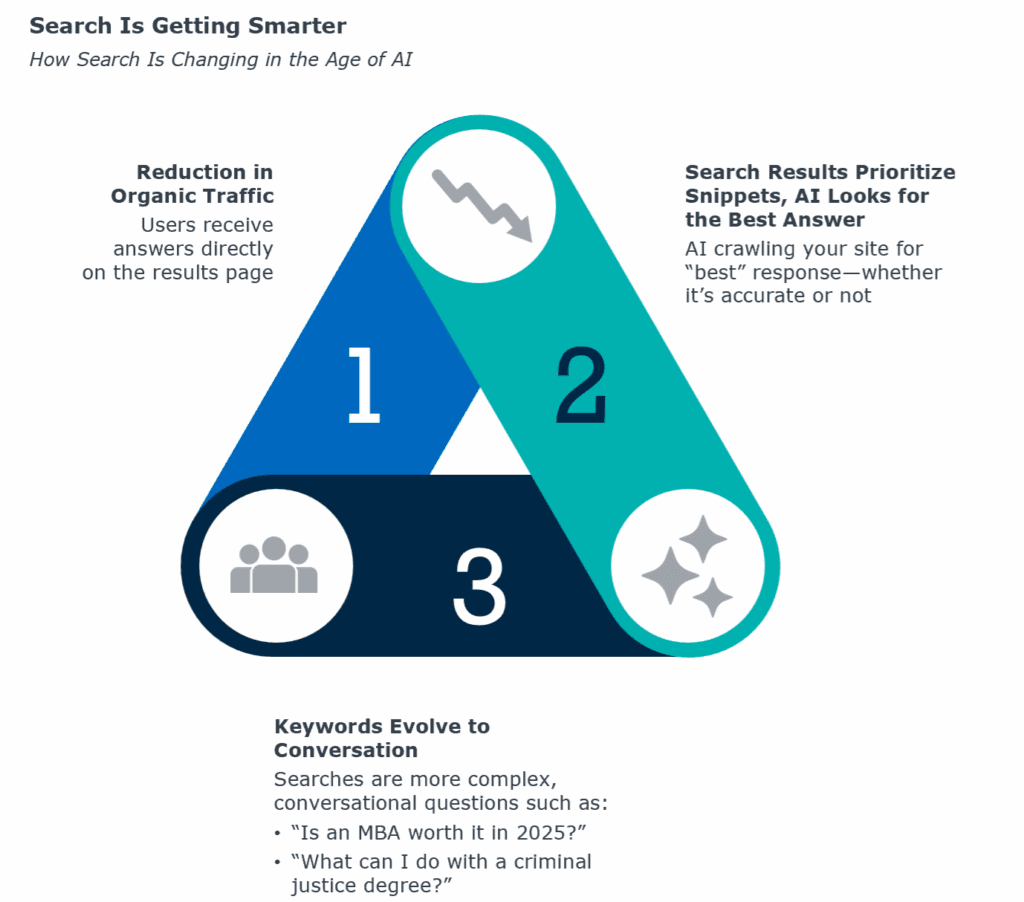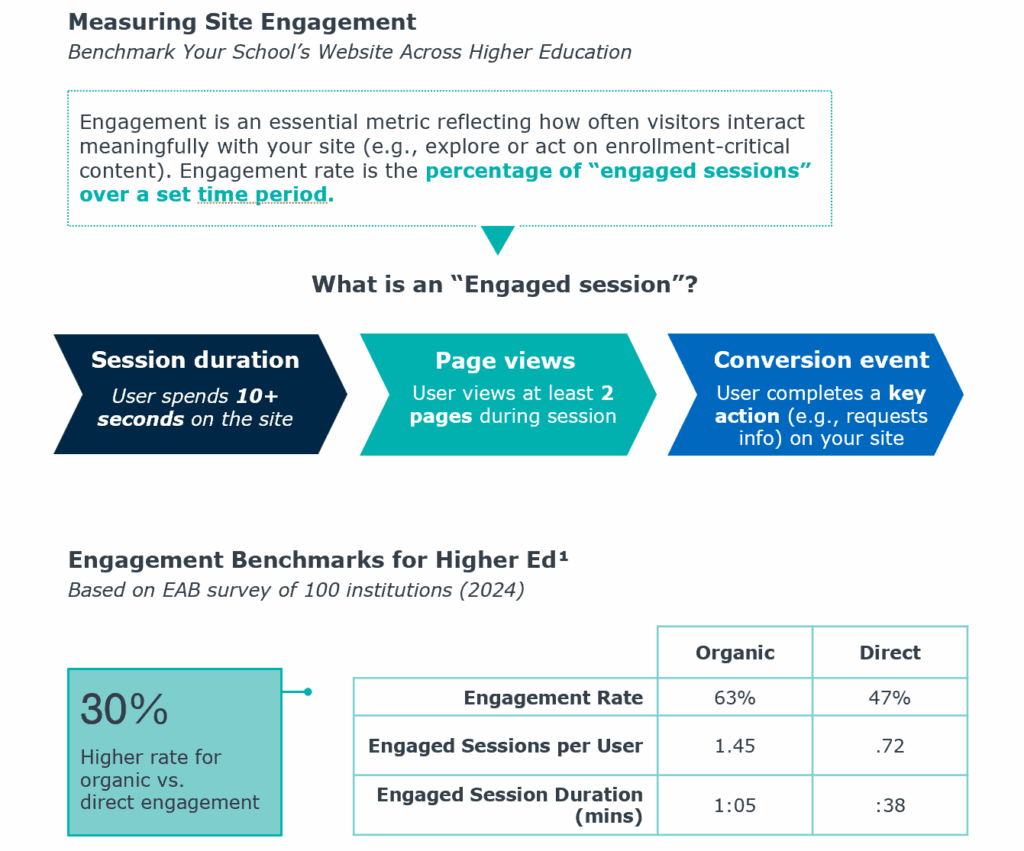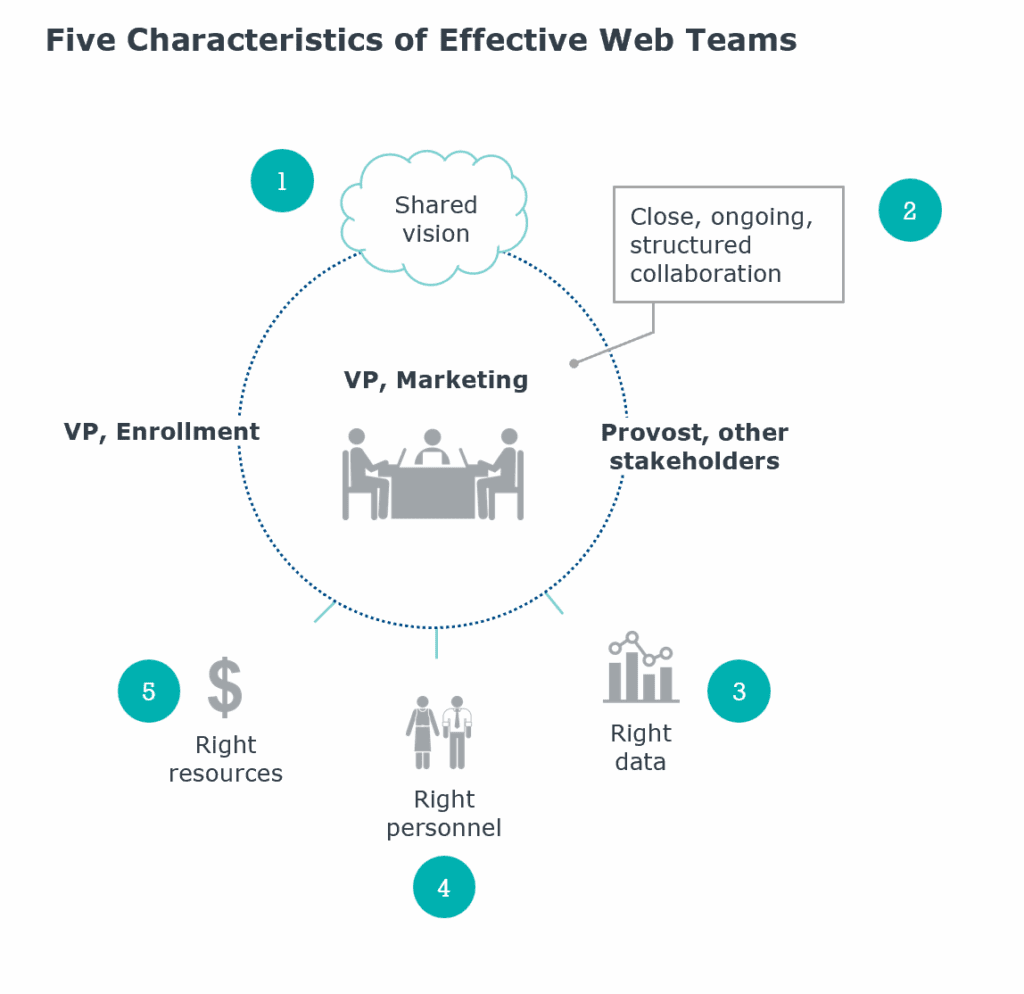Is your college website AI-ready and built to drive enrollment?
Despite seismic shifts in the digital landscape, EAB research shows that your website remains the most trusted source of information for prospective students—and one of your most powerful enrollment tools. 81% of Gen Z and millennials said a college’s website helped them decide whether the school was a good fit.
But many .edu sites haven’t kept pace with how students search, engage, and make decisions.
EAB’s updated guide, The Enrollment-Optimized College Website 2.0, gives marketing and enrollment leaders the tools to evaluate their current site and focus on the improvements that matter most for driving enrollment. Here’s a quick look at the guide’s three core imperatives, and what leaders should take away from each.
1. Maximize visibility: Master the new rules of search
In today’s AI-powered search landscape, showing up at the top of Google results isn’t enough. AI summaries now dominate the search window, pushing organic and paid links out of view. But AI summaries are also still prone to errors, pulling in what it deems the “best” answer, even if it’s outdated or irrelevant.
That’s a growing concern for colleges. We’ve seen AI tools pull in archived pages with old deadlines, programs, or incorrect costs. If your content isn’t optimized and well-structured, it may misrepresent your institution—or worse, it may not appear at all.
To stay visible, your site content needs to reflect how people search in the age of AI. Optimizing for generic keywords like “best colleges for data science” doesn’t cut it anymore. Instead, focus on answering the real questions students are asking, using natural, conversational language that mirrors how they type or speak into search tools.
For example, a student might ask, “Which data science programs are best for someone interested in criminal justice policy?” and expect your site to provide a clear, helpful answer right away. Your content should also demonstrate Experience, Expertise, Authority, and Trust (E-E-A-T), signaling to both search engines and prospective students that your site is a trustworthy, up-to-date source.

Review the checklist to assess your college website’s search visibility:
We regularly update our SEO keywords
We perform keyword optimization on content and metadata for our enrollment-critical pages at least once every six months.
We regularly assess our search-rank performance
At least once every three months, we track our institution’s search rank for key enrollment-related queries, including variations on the searches below.
- Colleges in our state
- Colleges in our state offering our most strategically important majors
- Specific types of colleges in our state (e.g., small liberal arts colleges)
We have audited our SEO strategy to ensure it accounts for AI search
Our strategy includes structured data; high-quality, authoritative content; and natural language that aligns with conversational queries.
Our .edu has undergone technical SEO
We have optimized the following SEO-critical technical aspects of our website:
- It has a sitemap.
- It has a robots.txt file.
- It uses canonical tags.
- It uses structured data (i.e., a schema).
- Average page-load time is faster than peer benchmark.
-
Key takeaway:
Search is still one of your biggest enrollment levers, but it’s playing by new rules. Focus on optimizing high-impact pages for search visibility, not just SEO rankings.
2. Drive engagement: Optimize for on-site experience
One in four prospective students now use AI chatbots (e.g., ChatGPT, Gemini, on college websites) during their college search. Many prospects are gathering information anonymously, before ever submitting a form or contacting your team.
That means your website needs to do more of the heavy lifting. When prospective students reach your site, they’re often high-intent and ready to act. But if your content is hard to find, confusing, or inaccessible, they may leave without taking the next step. Clear content strategy, intuitive page structure, strong calls to action, and accessible design are now baseline expectations. And while traffic volume still matters, the real indicator of success is engagement rate—how effectively your site is helping students explore, decide, and convert.

Review the checklist to assess your college website’s engagement strength:
We provide shortcuts to keep users oriented
Our site uses the following navigation features to keep users from getting lost:
- All enrollment-critical pages feature a “home” button that links back to the school’s main page.
- Our website uses breadcrumbs to assist with navigation on portions of the site with deep hierarchical content.
- We use jump links to make long-scrolling pages easier to navigate.
Our content always puts students at the center
All content on our enrollment-critical pages frames key differentiators of our brand relative to prospective students’ concerns, interests, hopes, and aspirations.
Our content meets all required and widely recognized accessibility standards
Our website and mobile app content meet current ADA accessibility standards (2024), in line with Title II guidance, requiring all existing and new content to comply with Web Content Accessibility Guidelines (WCAG) 2.1 AA standards.
We capture website interaction at the level of the individual user
Our information systems capture data on individuals visiting enrollment-critical pages on our website. Interaction data across successive visits is attached to their record, creating a detailed profile that evolves over time.
-
Key takeaway:
When students land on your website, the experience needs to match their expectations. Focus on making your enrollment-critical pages clear, accessible, and action-oriented to turn interest into enrollment momentum.
3. Build the right team and infrastructure
A high-performing website requires close collaboration between enrollment, marketing, and IT. But shared ownership doesn’t always mean shared goals. Without clear roles, processes, and priorities, your site risks becoming fragmented, slow to update, and misaligned with enrollment needs.

Enrollment leaders don’t need to manage the whole site, but they do need influence over the pages that matter most. Marketing and enrollment leaders can start by defining what success looks like, assigning clear responsibilities among stakeholders, and setting a content strategy that supports enrollment.
Many institutions face staff or skill gaps that hold back web performance. In these cases, external experts can help you move faster while staying aligned to institutional goals.
Review the checklist to assess organizational effectiveness:
We have full staff coverage for core website capabilities
Our institution has clearly identified personnel responsible for the aspects of website design and maintenance listed below. In cases where multiple individuals are responsible for a single function, their respective purviews and responsibilities are clear.
- Front-end development
- Back-end development
- Content management system administration
- Content creation (e.g., copywriting, video production, etc.)
- Content strategy
- Search engine optimization (SEO)
- Website analytics
Our website has clear goals
Our school’s website has enrollment-specific goals that were developed in partnership with marketing and academic leadership and have been signed off on by sponsors in senior administration.
Enrollment-critical content involves stakeholders from the start
We collaborate early with key stakeholders (e.g., department heads) who understand enrollment goals, and ensure enrollment leaders understand theirs.
Self-benchmarking
Our monthly reporting on the metrics listed above includes year-over-year comparisons (i.e., current value versus value for the same time period one year ago).
-
Key takeaway:
To drive enrollment impact, clarify your .edu site stakeholder roles and priorities—and focus your effort on the pages that matter most. If internal capacity is tight, outside support can help you move forward faster.
Your next step: Start where it matters most
You don’t need a full redesign to drive enrollment gains. With the right strategy and focus, your existing site can better support prospective students and guide them toward applying.
Start with your enrollment-critical pages. Are they visible in search? Do they reflect what students care about? Do they guide action? That’s where you’ll see the biggest impact—and the clearest path to enrollment growth.

More Blogs

AI visibility is critical when competing for student enrollments

What changed in the graduate lead gen landscape in 2025
